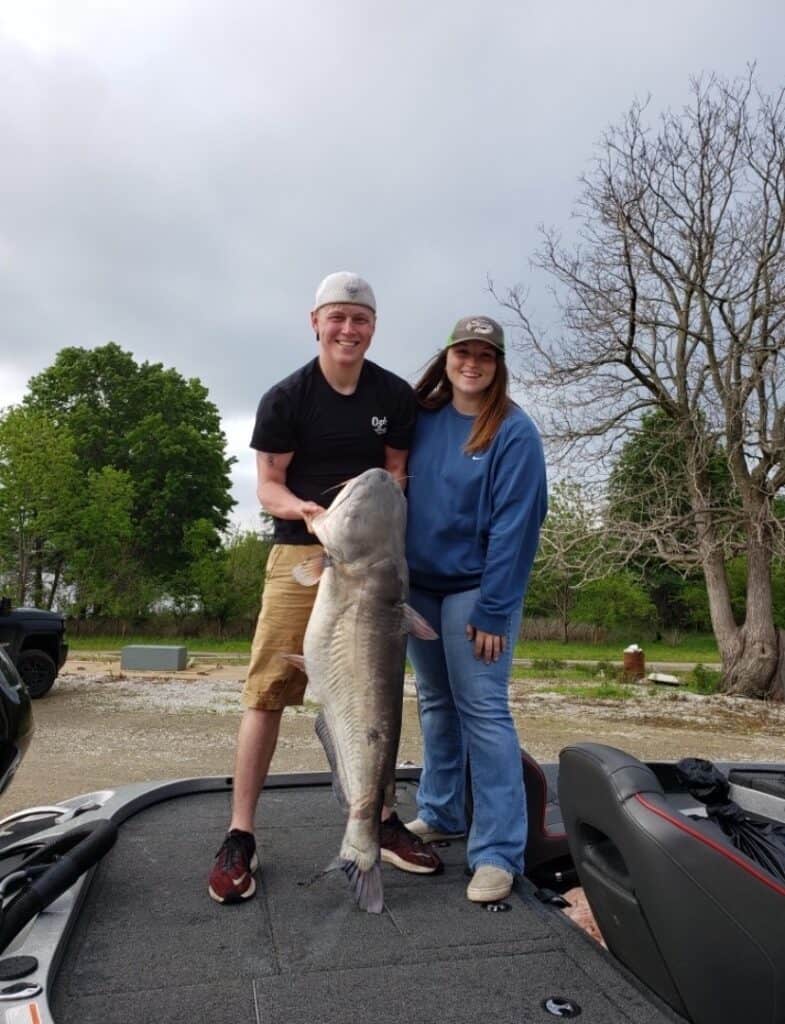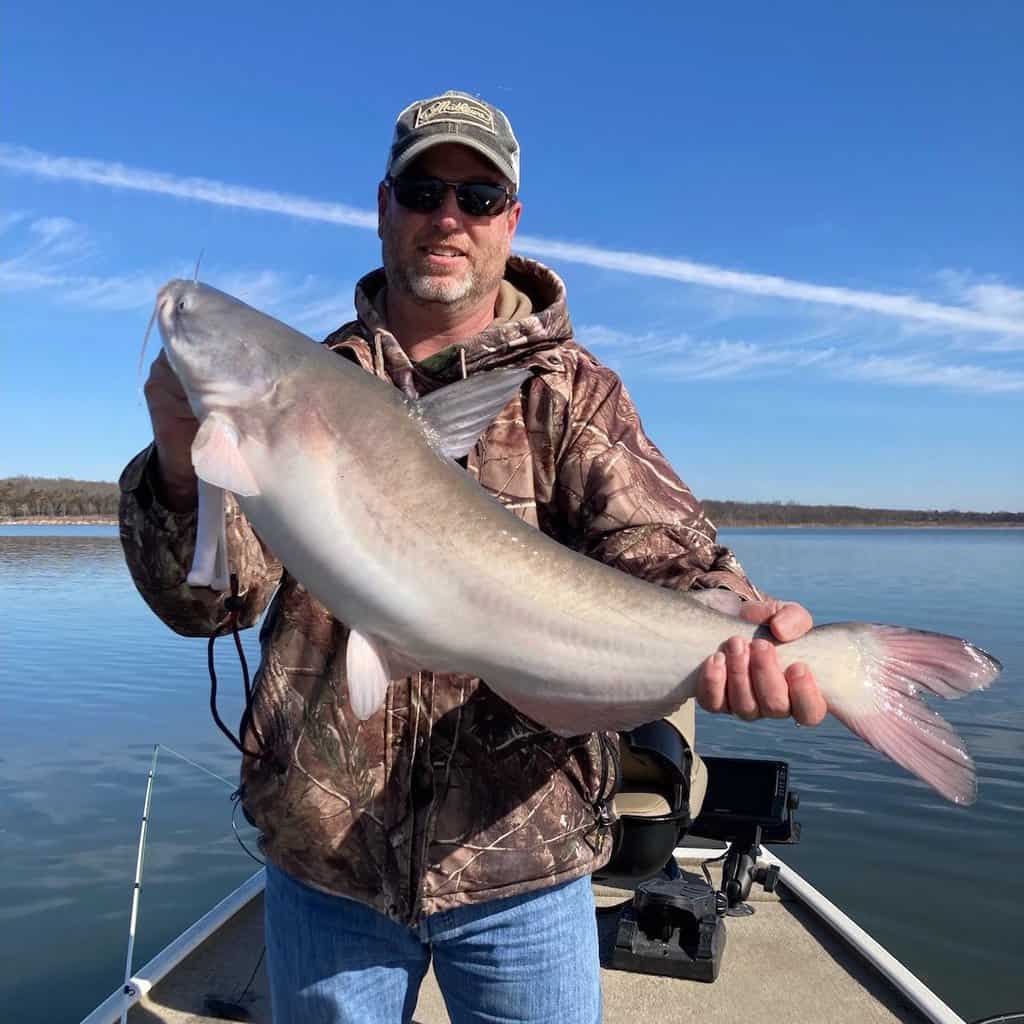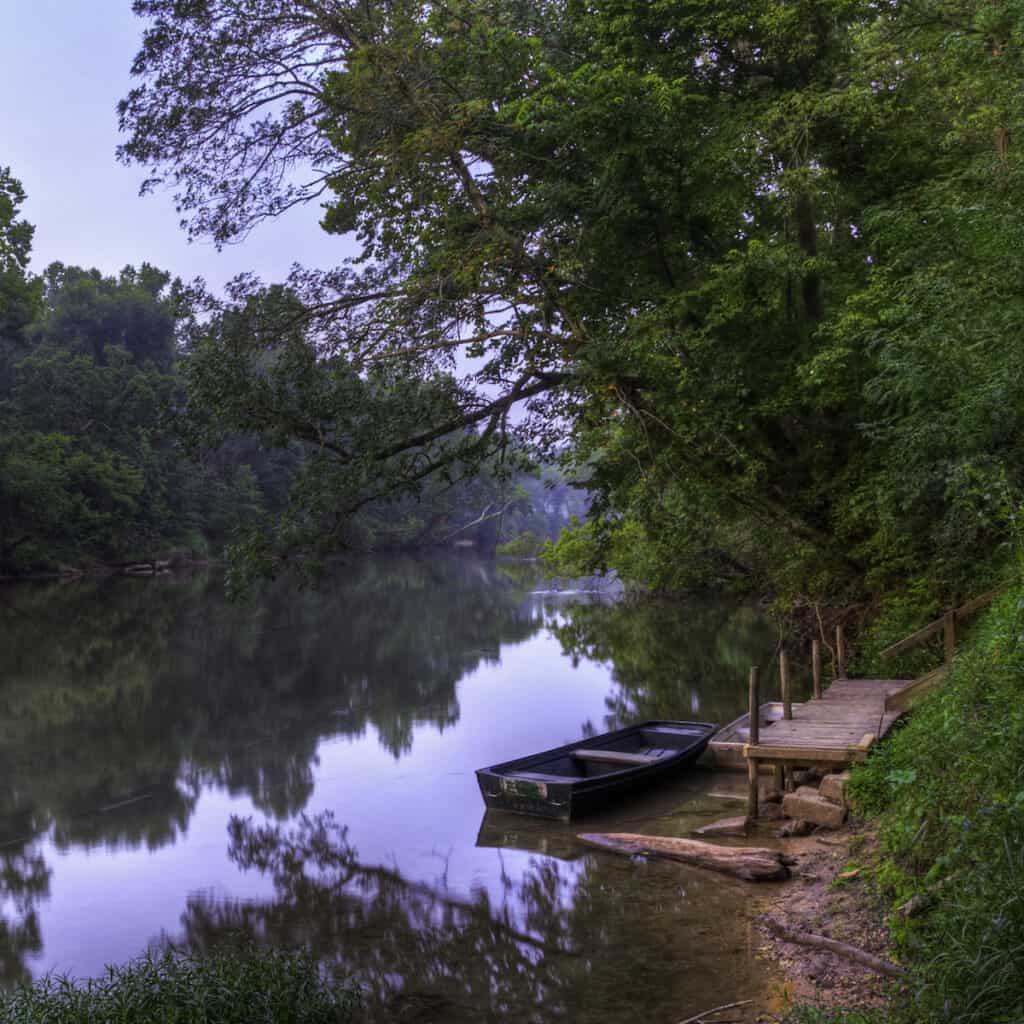Missouri has no shortage of places to catch one of America’s favorite fish, the catfish.
However, some places consistently rank among the best when it comes to catfishing in Missouri. Since there are still lots of those, chances are you’re not far from one of them.
Perhaps it’s no surprise why so many Missourians love catching catfish.
If you want to jump straight to the best catfishing in your part of the state, simply click the table of contents to jump right in.
What Kinds of Catfish are in Missouri?
Three primary species of catfish catch the interest of Missouri anglers: channel catfish, blue catfish, and flathead catfish. Each has a unique appeal for anglers, so we’ll spend a little time telling you about each one.
Channel Catfish
Channel cats are the most common catfish and are often confused with blue cats; however, there are a few differences to look for to tell them apart.
The first is size. Channel catfish simply don’t get as big as blue catfish. If you catch a catfish over 25 pounds, chances are pretty good it’s a blue cat, although the biggest channel catfish can grow to over 30 pounds.
You can look at the color and anal fin shape to distinguish between similar-sized blue and channel cats.
Channel catfish will be more greenish-gray, and the smaller ones will have small black spots. If you are still unsure, a channel cat has 29 or fewer rays on its rounded anal fin.
Blue Catfish
Blue catfish can grow to over 125 pounds to dwarf even a big channel catfish.
While channels tend to have a greenish hue, this species is more often blueish-gray, hence their name “blue catfish.”
Blue cats have a straight anal fin with 30 or more rays.
Anglers often catch blue catfish in the same areas as channel cats.
Flathead Catfish
Flatheads are easy to tell the difference between blues and channels. They’re green or brown, with that characteristically flattened head and a rounded tail.
Flatheads are more elusive than the other two species.
Yet, they still grow well over 50 pounds, making them the second-largest catfish in Missouri.
Bullhead Catfish
Like almost anywhere in America, bullhead catfish are also found in Missouri. Black, brown and yellow bullheads can be very common, depending on the waterway and part of the state you’re fishing.
However, this article won’t cover these smaller, less-prized species because anglers typically want to know where and how to catch the larger three species found in Missouri.
How to Catch Catfish
There are a few different methods to catch catfish in Missouri.
Rod & Reel
Using a rod and reel is the most sporting way of catching catfish, but it’s often the slowest because you’re limited in the amount of water you can cover.
I recommend using heavy-duty gear in case you set the hook on a monster blue cat or flathead. Catfish aren’t shy when it comes to using heavy line and tackle.
Rod and reel fishing is also great because it’s accessible to nearly everyone, whether you have a boat or not. It’s the only method we discuss here that is well-suited for bank fishing.
Jugs
Jugs aren’t as fun as fighting a big catfish on a fishing rod, but they are an excellent way to stock up on catfish for a fish fry.
This setup includes a line with a weight and a baited hook tied to a jug or a pool noodle.
The buoyancy of the jug or other float creates resistance that sets the hook in the fish’s mouth when it bites the bait.
You can set out multiple jugs in an area to maximize your chances of catching enough fish for a meal.
Check the Missouri fishing regulations to see how many you can set out.
Trotlines
A trotline is a strong line with many droplines, hooks tied from a tree, or heavy rock across a channel.
The line has to be set far below the water’s surface so that boats don’t run it over with their props, but like jug fishing, this is another way to catch a lot of catfish in a few hours.
Once again, check the regulations for the number of hooks allowed on a trotline.
Where to Go
Missouri is loaded with excellent catfishing opportunities. No matter where you are in the state, there is a river or lake with catfish waiting to get caught.
Okay, they might not be begging you to catch them, but my point is you’re not far from catching catfish!
We will begin by showing you the best catfish fishing rivers and then transition to the top catfishing lakes in different parts of Missouri.
Best Catfish Fishing Rivers in Missouri
Meramec River
The Meramec River is home primarily to channel catfish and flathead catfish. You can catch them using live or cut bait (bluegill, shad, or skipjack) on rods and reels, limb lines, and trotlines.
The best places to go are boulder runs, downed trees, and root wads because catfish love to hang around these structures in this river.
To have the greatest success, you will need a boat to fish the river; but there are decent opportunities to fish from the banks, including around public boat ramps.
The Meramec River (sometimes spelled Maramec River) flows northeast across Missouri before spilling into the Mississippi River south of St. Louis (near Arnold and Oakville).
Mississippi River
Anglers hook channel, blue and flathead catfish throughout the mighty Mississippi River flowing along the eastern border of Missouri. However, blue catfish are not as abundant as the other two species on the upper portion of the river.
While shore anglers also catch catfish, a boat will give you access to the best fishing locations in such a big river. Look for catfish holding behind and around sand bars, wing dikes, rocky banks, and woody cover.
You can use the same techniques and baits as fishing other rivers in Missouri.
Missouri River
With all three species of catfish in the Missouri River as it flows clear across the state, expect it to fish much like the Mississippi.
A boat will improve success rates on any river, especially the big rivers like the Missouri and Mississippi.
Fish the same baits, techniques, and habitats, such as slack waters with deep holes, below dams, and around structures that you would in other rivers.
When fishing big rivers like the Mississippi and Missouri, it’s best to break them into smaller portions instead of getting overwhelmed with the amount of fishable water. Look for the high percentage areas like the previously mentioned holding areas, and focus on fishing those.
I also can’t stress safety enough; these big rivers have barge traffic; barges cannot stop quickly or make quick maneuvers, unlike other boats. So be sure to stay out of their way!
Osage River
Historically, the Osage River flowing through central Missouri is known for producing monster-sized catfish. Though these days they’re not as common as we’d like to hope for, giant catfish still swim here.
The three primary species of catfish inhabit the Osage River, and the typical catfishing techniques and baits work here.
While there are public boat ramps and public bank access points, the ideal option is to have a boat to get to the best locations.
Those top locations change throughout the year as the catfish follow the baitfish up and down the river. During the spring, they follow their food to the warmer, shallow water. Early season catfish also search for shallow caverns to make a nest.
Summer brings the catfish to the deep holes and around structures, though these are great places to check for fish all year.
In the fall, catfish will search for food to bulk up before winter.
During the winter, catfish typically stay deep and are less active, but a well-placed bait can still catch fish.
Catfish Fishing Near St. Louis & Southeastern Missouri
In addition to several of the rivers discussed above, the following lakes have the best catfish fishing in the St. Louis area. This section also features lakes farther into the southeastern corner of the state.
I’ve listed the lakes in alphabetical order in this area.
Clearwater Lake
Clearwater Lake is a 1,630-acre lake near Piedmont in Reynolds and Wayne counties. Blue and channel cats are the most abundant catfish species in the lake.
With boat ramps scattered around the lake, there are plenty of opportunities to get on the water.
I recommend starting at a creek mouth because catfish use the creek channels as a highway to access different locations of the lake.
Just below Clearwater Lake dam in the Black River also is excellent for catfishing.
The Missouri Department of Conservation has sampled flatheads up to 40 pounds from this part of the Black River. However, channel catfish are still the most abundant species.
Council Bluff Lake
Known for its channel catfishing, Council Bluff Lake in northern Iron County is a 440-acre lake that allows boats but not wakes, keeping most speed boaters off this lake.
There are many bank fishing locations for those without a boat. I recommend using nightcrawlers or small cut bait on a rod and reel for the best results.
Find an abrupt depth change near a flat and try fishing there first.
The lake was stocked with blue catfish many years ago, and there are rumors of them surviving to become giants, so don’t be shocked if you hook into a blue cat while chasing channel catfish.
Creve Coeur Lake
This 320-acre park lake in the St. Louis suburb of Maryland Heights provides easy bank access to anglers. Boats are allowed; however, only electric motors can be used, not combustible engines. Of course, oars or paddles are an option as well.
Channel catfish are the fish to catch from this small suburban lake. This means using worms, stink bait, or small live bait will work best.
Finding the creek channel and fishing along it will yield the best results as the channel cats will use it as a highway to move from one end of the lake to the other.
Lake Wappapello
There are plenty of fishing spots at Lake Wappapello State Park in the southeastern portion of the state, except you can’t fish near the boat ramp and swimming area.
Channel cats are the most common catfish in the lake. Most are eater-sized, but you might stumble across a few big ones while fishing the creek channels and flats.
You’ll significantly increase your chances of catching fish fishing from a boat. But there are places to fish from the bank and still succeed.
Minnows and earthworms are two excellent baits. Prepared baits, such as stink bait, are also viable options.
The lake straddles Wayne and Butler counties, north of Poplar Bluff.
Catfish Fishing Near Kansas City and Northwestern Missouri
In addition to the Missouri River, the following lakes, reservoirs, and city ponds offer plentiful opportunities to land catfish near Kansas City.
We’ll also tell you about some lakes within a reasonable drive both north and south of the city if you’re looking to get out but not too far.
Big Lake
Channel catfish are the most commonly caught fish species in Big Lake, located near the Missouri River in Holt County, about an hour and a half north of Kansas City.
Big Lake offers bank access, fishing docks, and boating access. You’ll have plenty of options when trying to catch a channel cat.
Casting from the bank with a rod and reel with stink bait, chicken liver, or earthworms as bait will give you a good shot when catfishing at Big Lake.
Fishing from a boat will boost your odds of catching catfish in this 646-acre lake.
James A. Reed Memorial Wildlife Area
There are 12 lakes that the Department of Conservation manages in the James A. Reed Memorial Wildlife Area stocked with several fish species, including channel catfish.
Some lakes are as small as one acre, while others are as large as 42 acres.
There is excellent bank access around most lakes. Boating has special regulations, so check the James A. Reed Memorial Wildlife area regulations before heading out!
Using a rod and reel is the way to catch channel catfish from the bank. Earthworms, stink baits, and small sunfish are the best baits to use.
The refuge is just 30 minutes southeast of Kansas City, just south of U.S. Route 50.
Jacomo, Lake
Lake Jacomo is located just southeast of Kansas City, near Blue Springs, and is regularly stocked with channel cats.
Channel catfish grow to the perfect eating size and are the most common catfish here, but there also are flathead catfish ranging from eater size to over 20 pounds.
Boats are allowed if they have a 25hp motor or smaller. Pontoons and sailboats are allowed with motors up to 40hp. Kayaks and canoes are common on the lake too.
There are many spots to fish from the bank if you don’t use a boat.
One of the best times for catfish is shortly after a significant rain when heavier water flows from tributaries into the lake. Channel cats will concentrate near the inflowing water in the backs of coves, searching for food.
Earthworms, stink bait, and cut bait will work well for channel cats. Flatheads prefer live bait but will also hit fresh-cut bait.
Longview Lake
Located just south of Kansas City, this 930-acre reservoir is home to some giant flathead catfish.
You can only use a rod and reel to catch fish here, so bank anglers aren’t at a complete disadvantage.
Though the flatheads grow large, you’ll find a bigger abundance of channel catfish right around the perfect size for filleting.
To target channel cats, use nightcrawlers or prepared baits in shallow areas near a drop-off. There is a daily limit of 10 channel catfish, which means you’ll be able to catch plenty for a fish fry.
When targeting flatheads, use live or cut bait near boulders and brush piles in deep water.
Montrose Lake
Catfishing is what draws anglers to Montrose Lake, west of Clinton and a little over an hour driving southeast from Kansas City.
Channel and flathead catfish are present in high enough numbers to keep most anglers happy just about any day.
Warm water flows into this 1,500-acre lake from the power generation station, which keeps the temperatures higher than in other lakes. This means the fish will be more active here during colder months than at most Missouri lakes.
Montrose is a no-wake lake, so kayak or canoe fishing is much safer, and you won’t have to be concerned with large boat waves.
You’ll find the most successful fishing for flatheads near brush piles or steep ledges. You’ll commonly find channel cats feeding on shallow flats.
The standard catfishing gear, baits, and techniques work at Montrose Lake.
Smithville Lake
Smithville Lake is known for its spectacular catfishing just north of Kansas City.
Channel catfish as well as flatheads are prevalent at this lake.
When targeting channel catfish, try focusing on the upper ends of the lake arms, shallow flats, around the islands, and main lake channels near flats.
The flatheads will spend most of their time around rocky and brushy structures, deep holes, and creek channels.
The best baits are live baits and the best time to go during the summer is at night when catfish are most active. Spring and fall months can be very good, too.
Troost Lake
Located just south of downtown Kansas City, Troost Lake is a city park lake with excellent bank access. This small lake is home to channel catfish and several other fish species that are fun to catch.
The best baits will be minnows, earthworms, or prepared baits. Due to the lake’s small size, you’ll unlikely catch a giant catfish, but they grow large enough for an excellent fight.
Small boats such as kayaks with electric motors are allowed on the 3-acre lake.
Southwestern Missouri Catfish Fishing
The lakes in this area are within easy reach of Springfield and other well-known Missouri cities such as Branson and Joplin.
Several fishing spots covered in this section are close enough for a day trip from Kansas City or Columbia.
These waters also are listed in alphabetical order.
Atkinson Lake
Regularly stocked with channel cats, Atkinson Lake offers many anglers an excellent opportunity to catch dinner since most of the cats will be the perfect eating size.
You can use a boat on the lake; however, if the motor is larger than 10 hp, you must keep it below the no wake speed.
Bank angling opportunities are also great, especially when using chicken liver and stink baits near the dam.
Atkinson Lake is closed to all activities from October 15-January 31.
The lake is located only slightly closer to Springfield than Kansas City and is easy to reach from either direction.
Bull Shoals Lake
Anglers might overlook Bull Shoals as a catfishing lake because of its spot as one of Missouri’s most incredible bass fishing lakes.
But this actually is good news for anglers interested in fishing less pressured water for catfish. You’ll find all three species of catfish in Bull Shoals, but the two primary species are channel catfish and blue catfish.
Cut bait and live bait will work best for blues and flatheads, while stinkbait, worms, and small cut bait will work well for channel cats.
You must be aware of unique fishing regulations when fishing Bull Shoals, so be sure to read those over before getting there.
You’ll need a boat to access some of the best fishing. However, there also are many opportunities to fish from the bank.
More: Complete Guide to Bull Shoals Lake Fishing
Fellows Lake
Near Springfield, Fellows Lake is known for the shot at catching muskies, but the channel catfishing can be incredible.
This 860-acre lake doesn’t allow boats with motors larger than 40-horsepower engines, so it’s great for kayaking, canoeing, and bank angling. Shore fishermen will find numerous locations to access the water’s edge.
Try using chicken liver, stink baits, nightcrawlers, or cut bait for the most success in catching channel catfish at Fellows Lake.
Brush piles have been placed around the lake by the Missouri Department of Conservation and are worth checking out if you have a boat.
I recommend asking the marina for specific fishing advice for the day, as they’ll be able to tell you how well other anglers have been doing lately.
Pomme De Terre Lake
Flatheads and channel cats are the catfish species living in Pomme De Terre Lake. Their abundance remains solid.
There are many bank-angling opportunities around the 7,800-acre lake if you don’t own a boat.
However, boat use will increase your chances of catching catfish, especially big ones, in this large reservoir.
I recommend using cut bait or nightcrawlers on a rod and reel or shad when jug fishing or running a trotline.
Pomme De Terre also is among the more than one dozen excellent places across Missouri to catch walleye, which may occasionally nab your nightcrawler or other baits.
Springfield, Lake
Catfish anglers are most likely to catch channel cats in Lake Springfield, with smaller numbers of flatheads also present.
This 318-acre lake has lots of submerged vegetation and brush for bait fish to hide in, which means predatory fish like catfish will be nearby.
With plenty of bank-fishing opportunities, you don’t have to have a boat to have a good time; however, a boat will give you more access to fishing spots.
Don’t overthink the baits; keep it simple as you would with most other lakes in Missouri. Nightcrawlers, live and cut shad, or live and cut sunfish all work well for catfish in this lake.
Stockton Lake
Stockton Lake is home to excellent channel cat and flathead fishing.
You’ll find that the large coves and upper end of the lake are where the best channel catfishing takes place while finding the deep channels near the structure is where you’ll most often catch the flatheads.
Fishing is not allowed at the boat ramps or the marina, but other public fishing areas exist.
You’ll need a boat to access the best locations. Jugs and trotlines baited with live bait are the primary way flatheads are caught, while channel cats will eat a wider variety of baits.
Also known as Stockton Reservoir, this large fishery was created with the damming of the Sac River near Stockton. It’s about an hour northwest of Springfield.
More: Complete Guide to Stockton Lake Fishing
Table Rock Lake
Table Rock Lake near Branson is another massive lake with a healthy channel and flathead catfish population, yet they remain relatively unpressured.
You’ll find channel catfish primarily in the river and creek arms, and you’ll discover flatheads more often in clear water portions of the lake. Flatheads measuring 30 inches and longer are somewhat common, so be prepared for a fight.
Live baits are best for flatheads, and prepared baits work well for channel cats. All techniques will catch both species, but trotlines and jugs typically land more flatheads than a rod and reel.
Try fishing at night if you’re struggling to catch fish when the sun is shining. Catfish are more active during the night, so you’re more likely to get a bite.
Table Rock Lake also is perhaps the best smallmouth bass fishing lake in Missouri, and is nationally known for these hard-fighting bass.
More: Complete Guide to Table Rock Fishing
Taneycomo, Lake
Lake Taneycomo, on the east side of Branson, is known as a trout fishery, and for a good reason. However, don’t be surprised if you stumble across channel cats.
More than likely, catfish won’t grow to monstrous proportions in this lake due to the high competition from trout for food, but you will catch eater-size channel cats in some of the pools.
The best way to target these catfish is to use earthworms, minnows, or lures that look like small bait fish.
More: Complete Guide to Lake Taneycomo Fishing
Truman Lake

All three catfish species are found in Truman Lake and at this writing are recovering in size and number, though they’re not back to their historical dimensions. However, with the help of special management practices, they might soon be there.
When targeting blue catfish, focus on flats near depth changes and channel swings. The best flathead locations are the upper areas of the Grand, Osage, and Tebo arms.
You’ll likely find channel cats in all locations.
The best baits for all three species remain constant with prepared baits and earthworms for channel cats, while blues and flatheads prefer to eat live or cut bait.
If you’ve had your fill of catfishing but still want some delicious fish fillets, Truman Lake also has a reputation for excellent crappie fishing if you know where to go on the massive reservoir.
More: Complete Guide to Truman Lake Fishing
Central Missouri Catfish Fishing
The waters organized in this section are toward the state’s middle and most easily reached from Columbia, Jefferson City, and other nearby communities.
Catfish opportunities here include the previously mentioned Missouri River and lower Osage River.
The centrally located lakes and reservoirs listed below may also be within a reasonable drive if you’re heading in from Kansas City, St. Louis, and other parts of the state.
Binder Lake
Small channel catfish are regularly stocked in Binder Lake, located near Jefferson City. However, after 1-2 years, these fish have grown enough to make an excellent fillet. Thousands of catfish stocked within the last few years are already big enough to be taken home for dinner.
You’ll find a boat ramp, fishing dock, and boating docks at Binder Lake, along with an RV campground, hiking trails, and public restrooms.
The typical catfish baits and techniques will also work here while fishing along ledges, the creek channel, or brush piles.
Lake of the Ozarks
Lake of the Ozarks sits near the middle of Missouri and carries a national reputation for outstanding bass fishing. Many anglers overlook its incredible catfishing.
With all three species of catfish in the lake, you never know which one is biting until you bring it up. Though you can use bait to target specific species, they all intermingle to a degree.
Channel catfish will be most commonly caught from the shore at Lake of the Ozarks, while flatheads and blues prefer deeper open water that’s only accessible by boat.
There are special regulations regarding catfishing at Lake of the Ozarks, so be sure you’re up to date on those.
The best baits are nightcrawlers, cut bait, and live bait.
More: Complete Guide to Lake of the Ozarks Fishing
Little Dixie Lake
Little Dixie Lake between Columbia and Fulton has a surprisingly diverse fish population for a relatively small lake. This is partly because Little Dixie Lake and nearby ponds are used for research by the MDC and the University of Missouri.
Channel catfish have been present since the 205-acre lake was built in 1957, but fishery managers more recently introduced blue catfish.
The blues are surviving well, with some reaching over 50 pounds.
There is a boat ramp, but special boating regulations are present on the lake.
Public land surrounds the lake, but most of it is heavily wooded and not easily accessible. I recommend staying in the maintained areas while fishing.
Mark Twain Lake
Mark Twain Lake is a really big lake with lots of angling opportunities.
All three species of catfish are found in abundance in this lake. The best chance of catching catfish is by boat, but Mark Twain State Park maintains a few public bank access areas where you also can hook into some good catfishing.
There are particular size limits regarding blues and flatheads, so be sure you’ve read the regulations before you try keeping a blue catfish or flathead catfish.
The typical techniques and locations are what work best at Mark Twain Lake.
The reservoir is a little over an hour northeast of Columbia and over two hours northwest of St. Louis.
More: Complete Guide to Fishing at Mark Twain Lake
Thomas Hill Reservoir
Thomas Hill Reservoir near Moberly is a warm-water power plant discharge overpopulated with channel cats, which means a couple of things of significance to catfish anglers.
First, there are plenty of catfish to catch and take home. Second, on average they’ll be small, which is the best eating.
The flatheads grow larger but still compete with channel catfish for food, so you’re less likely to find trophy-sized flathead catfish in Thomas Hill.
The typical trotlines and jug lines will be your best bet for catching flatheads in the creek and river channels, while you’re likely to catch channel catfish on rod and reel using typical catfish offerings including prepared baits or live bait.
Since this reservoir it has a continuous source of warm water during the winter, the fish will be more active during colder weather at this 4,500-acre lake than in most of Missouri’s top catfish fishing lakes.
Catch More Catfish
Follow the bait suggestions and other recommendations shared above and you’ll be catching catfish in these Missouri lakes and rivers in no time.
If you want to learn even more about catching these whiskered fish, check out all the simple tips in our guide to catfish fishing techniques.




